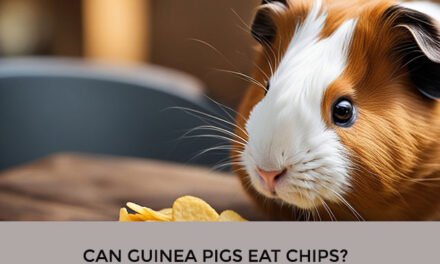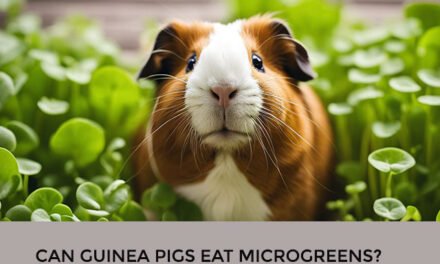Guinea pigs are adorable and friendly pets that require a specific diet to keep them healthy. As a responsible pet owner, it’s essential to know which foods are safe for your guinea pig to consume. One such food that may come into question is rhubarb leaves. In this article, we will explore whether guinea pigs can eat rhubarb leaves and the potential risks associated with feeding them to your furry friend.

Rhubarb leaves are known to contain high levels of oxalic acid, which can be toxic to both humans and animals. While the stalks of rhubarb are safe for human consumption, the leaves are not. Therefore, it’s natural to wonder if the same applies to guinea pigs. As herbivores, guinea pigs require a diet rich in fiber, vitamins, and minerals. However, not all plants are safe for them to eat, and some may cause more harm than good. In the following sections, we will examine the potential risks of feeding rhubarb leaves to guinea pigs and provide alternative food options to keep them healthy and happy.
Guinea Pig Diet Essentials

When it comes to feeding our guinea pigs, it’s important to provide them with a balanced diet that meets all of their nutritional needs. Here are some essential elements to keep in mind when planning your guinea pig’s diet:
Hay
Hay is a crucial part of a guinea pig’s diet. It provides the fiber they need to maintain good digestive health and keep their teeth in good condition. We recommend providing your guinea pig with unlimited access to good quality hay, such as timothy or orchard grass hay.
Pellets
Pellets are another important part of a guinea pig’s diet. They provide essential vitamins and minerals that may be lacking in other parts of their diet. However, it’s important not to overfeed pellets, as they can be high in calories. We recommend feeding your guinea pig a small amount of pellets each day, based on their weight and age.
Vegetables
Vegetables are a great way to provide your guinea pig with additional vitamins and minerals. However, not all vegetables are safe for guinea pigs to eat. It’s important to avoid feeding them foods that are high in oxalic acid, such as rhubarb leaves, spinach, and kale. Instead, opt for vegetables that are high in vitamin C, such as bell peppers, broccoli, and parsley.
Fruits
Fruits are a great source of vitamin C for guinea pigs, but they should be fed in moderation due to their high sugar content. We recommend feeding your guinea pig small amounts of fruit as a treat, such as strawberries, blueberries, and apples.
By providing your guinea pig with a balanced diet that includes hay, pellets, vegetables, and fruits, you can help ensure that they stay healthy and happy.
Toxicity of Rhubarb Leaves

Rhubarb leaves contain high levels of oxalic acid, which can be toxic to guinea pigs. Oxalic acid binds with calcium in the body, leading to the formation of calcium oxalate crystals. These crystals can cause damage to the kidneys and urinary tract, leading to kidney failure and other health problems.
Symptoms of rhubarb leaf poisoning in guinea pigs include loss of appetite, diarrhea, vomiting, lethargy, and abdominal pain. In severe cases, the guinea pig may suffer from convulsions, coma, or death.
It is important to note that while the stems of rhubarb are safe for guinea pigs to eat in moderation, the leaves should be avoided entirely. Even small amounts of rhubarb leaves can cause serious health problems for guinea pigs.
In conclusion, we strongly advise against feeding rhubarb leaves to guinea pigs. If you suspect that your guinea pig has ingested rhubarb leaves, seek veterinary care immediately.
Health Risks for Guinea Pigs Eating Rhubarb Leaves

As much as guinea pigs love to munch on fresh greens, not all plants are safe for them to consume. Rhubarb leaves, for instance, are known to contain high levels of oxalic acid, which can be toxic to guinea pigs.
When consumed in large quantities, oxalic acid can bind with calcium and cause the formation of kidney stones. This can lead to urinary tract problems, which can be fatal if left untreated.
In addition to kidney problems, guinea pigs that eat rhubarb leaves may also experience digestive issues such as diarrhea and vomiting. This is because rhubarb leaves are high in fiber and can be difficult for guinea pigs to digest.
To keep your guinea pig safe and healthy, it’s important to avoid feeding them rhubarb leaves. Instead, opt for safe and nutritious greens such as lettuce, spinach, and kale. If you suspect that your guinea pig has consumed rhubarb leaves, be sure to contact your veterinarian immediately.
Safe Alternatives to Rhubarb Leaves for Guinea Pigs
As we have mentioned earlier, rhubarb leaves are not safe for guinea pigs to consume. However, there are plenty of other vegetables and fruits that are safe and healthy for them to eat. Here are some safe alternatives that you can offer your furry friend:
Vegetables
- Bell peppers: Rich in vitamin C and low in oxalates, bell peppers are a great snack for guinea pigs.
- Carrots: High in fiber and vitamin A, carrots are a healthy and tasty treat for guinea pigs.
- Cucumber: Low in oxalates and high in water content, cucumbers are a refreshing snack for guinea pigs.
- Zucchini: Low in oxalates and high in vitamin C, zucchini is a safe and healthy vegetable for guinea pigs.
Fruits
- Apples: Rich in fiber and vitamin C, apples are a great snack for guinea pigs. Make sure to remove the seeds and core before feeding.
- Blueberries: High in antioxidants and vitamin C, blueberries are a tasty and nutritious treat for guinea pigs.
- Strawberries: Low in sugar and high in vitamin C, strawberries are a healthy and delicious snack for guinea pigs.
- Watermelon: High in water content and vitamin C, watermelon is a refreshing treat for guinea pigs.
Remember to always introduce new foods slowly and in small quantities to avoid upsetting your guinea pig’s digestive system. Offer a variety of vegetables and fruits to ensure a balanced diet and consult with a veterinarian if you have any concerns about your guinea pig’s diet.
Identifying Unsafe Foods for Guinea Pigs
As responsible guinea pig owners, we must ensure that our furry friends receive a balanced and healthy diet. This means avoiding foods that can be harmful to their health. Here are some common foods that are unsafe for guinea pigs:
Rhubarb Leaves
Rhubarb leaves are toxic to guinea pigs and should be avoided at all costs. They contain high levels of oxalic acid, which can cause kidney damage, seizures, and even death.
Chocolate
Chocolate contains theobromine, which can be toxic to guinea pigs. Even small amounts can cause vomiting, diarrhea, and seizures.
Avocado
Avocado contains persin, which can be toxic to guinea pigs. It can cause heart damage, respiratory distress, and even death.
Potatoes
Potatoes contain solanine, which can be toxic to guinea pigs. It can cause digestive problems, seizures, and even death.
Onions and Garlic
Onions and garlic contain thiosulphate, which can be toxic to guinea pigs. It can cause anemia, digestive problems, and even death.
In conclusion, we must be careful about what we feed our guinea pigs. By avoiding these unsafe foods, we can help ensure that our furry friends stay healthy and happy.
Preventing Dietary Hazards in Guinea Pigs
As responsible guinea pig owners, we must ensure that our furry friends are eating a healthy and balanced diet. While it can be tempting to offer them a variety of foods, it’s important to remember that not all foods are safe for guinea pigs to eat. Here are some tips to prevent dietary hazards in guinea pigs:
Avoid Toxic Foods
Some foods can be toxic to guinea pigs and should be avoided at all costs. These include chocolate, caffeine, alcohol, avocado, garlic, onions, and rhubarb leaves. Rhubarb leaves contain a high level of oxalic acid, which can cause kidney damage and even death in guinea pigs. It’s best to stick to safe and healthy foods for your guinea pig’s diet.
Offer a Balanced Diet
Guinea pigs need a balanced diet that includes hay, fresh vegetables, and a small amount of pellets. The majority of their diet should consist of hay, which provides the necessary fiber for their digestive system. Fresh vegetables should be offered daily, and should include a variety of options such as bell peppers, carrots, and leafy greens. Pellets should be given in moderation, as they are high in calories.
Introduce New Foods Slowly
When introducing new foods to your guinea pig’s diet, it’s important to do so slowly. This will help prevent digestive upset and ensure that your guinea pig tolerates the new food well. Start by offering a small amount of the new food and gradually increase the amount over a few days.
By following these tips, we can ensure that our guinea pigs are eating a healthy and safe diet. Remember to always consult with a veterinarian if you have any questions or concerns about your guinea pig’s diet.
Frequently Asked Questions
Are rhubarb leaves safe for guinea pigs to consume?
No, rhubarb leaves are not safe for guinea pigs to consume. They contain high levels of oxalic acid, which can cause kidney damage and other health issues in guinea pigs.
Which vegetables are harmful to guinea pigs?
In addition to rhubarb leaves, guinea pigs should avoid consuming vegetables that are high in oxalic acid, such as spinach and parsley. They should also avoid vegetables that are high in calcium, such as kale and collard greens, as well as those that are high in sugar, such as carrots and corn.
What are the best vegetables to include in a guinea pig’s daily diet?
The best vegetables to include in a guinea pig’s daily diet are those that are high in vitamin C and low in calcium and sugar. Examples include bell peppers, cucumbers, and leafy greens like romaine lettuce, arugula, and dandelion greens.
Can guinea pigs eat flowers, and if so, which kinds?
Yes, guinea pigs can eat certain types of flowers, such as dandelions, marigolds, and pansies. However, it’s important to make sure that the flowers are free of pesticides and other harmful chemicals.
What common plants are considered toxic to guinea pigs?
Common plants that are considered toxic to guinea pigs include avocado, chocolate, onions, garlic, and tomato leaves. It’s important to keep these plants out of reach of guinea pigs to prevent accidental ingestion.
How should a balanced daily diet for a guinea pig be composed?
A balanced daily diet for a guinea pig should consist of unlimited hay, a small amount of high-quality pellets, and a variety of fresh vegetables. Fresh water should also be available at all times. It’s important to avoid overfeeding guinea pigs and to monitor their weight regularly to ensure they maintain a healthy body condition.





